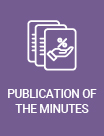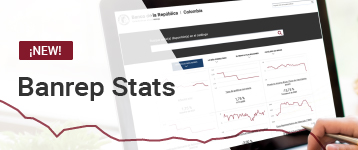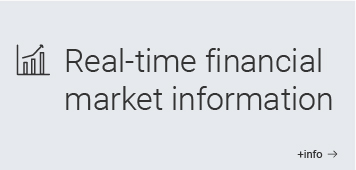Minutes of the Meeting of the Board of Directors of Banco de la República Held on October 30, 2014
A regular meeting of the Board of Directors of Banco de la República was held in the city of Bogotá D.C. on October 30, 2014. In attendance were Mr. Mauricio Cárdenas Santamaría, Minister of Finance and Public Credit, Mr. José Darío Uribe Escobar, Governor and Managing Director of Banco de la República, and Board Members Carlos Gustavo Cano Sanz, Ana Fernanda Maiguashca Olano, Adolfo Meisel Roca, César Vallejo Mejía and Juan Pablo Zárate Perdomo.
These minutes contain a summary of how Banco de la República’s technical team views the macroeconomic situation (Section 1), followed by a review of the key policy discussion points considered by the Board of Directors (Section 2).
A more detailed description of the macroeconomic situation prepared by the technical staff from the Central Bank is provided in the data section of the September 2014 edition of the Inflation Report, as well as in the statistical appendix.
1. MACROECONOMIC CONTEXT
Regarding the macroeconomic context, the technical staff highlights the following elements:
- In the present report, the growth forecast for external demand was reduced for this and the following year, as compared to the estimations from the previous quarter. The new projections suggest that in 2015 the average recovery of our commercial partners could be slower and prompted chiefly by the American economy. The euro zone could record a low growth in its GDP, but somewhat higher than what had been estimated for 2014. China could continue with their slowdown, while the majority of its partner countries in the region could recover in the following year, but would present lower growth rates than their respective potential.
- The risk premium measures adopted by several countries of the euro zone, as well as by some emerging economies, have increased, although moderately. The deterioration observed in the economic activity in some of these economies together with the greater uncertainty about their recovery partly explains this behavior. Additionally, the fall in the prices of the basic goods that some of these economies export, chiefly that of oil, also contributed to increase the risk measures. With this, their currencies have depreciated against the US dollar.
- In the United States, appreciation of the dollar and the fall in the international energy prices could contribute to reduce production costs and to reduce inflation. The unemployment rate descended again, but to levels that do not yet generate pressures of salary costs upon the prices. The lower quote for gasoline would also be an incentive for households to increase their expense. Nevertheless, the weaker rally of its commercial partners, together with the risks of a slowdown in the external demand, increased uncertainty upon the performance of its exportation sector.
- Facing the prospect of a lower inflation in the United States, as well as the greater risks of a slowdown in commerce worldwide, the average of the market expects that the first increase in the interest rate of the FED could take place towards the end of 2015, instead of in June next year, as had been projected a quarter ago. This more distant horizon regarding this increment contributed to the downturn in the long-term interest rates.
- The current levels in the international price of oil are situated way below the forecast produced by the technical staff, while those of coffee continue to be high. Other basic goods imported by Colombia such as corn, wheat, and soy, have also presented important downturns in their international quotes. In net results, the terms of trade have descended more than had been forecast, which is a situation that will be reflected on a lower national income if it continues to be sustained.
- The weakness in the external demand as well as lower international prices of the basic mining goods have been reflected on the behavior of the country's external sales. Until August 2014, the total exports in dollars have plummeted at a yearly rate of 2.7%. In this period, those of agricultural origin have presented high increases due to the exportations of coffee and banana, while those of mining and other sectors have descended. In the margin, for the bimester of July-August, the agricultural and other sectors presented high annual growths, while the mining sector descended, but less intensely.
- Until August, the imports in dollars have grown 6.8%, which is explained by the increase of those destined to raw materials, consumption, and, to a lesser extent, to capital goods. In the bimester of July-August, the external purchases addressed to consumption as well as to capital goods accelerated; those of raw materials presented a lower increase rhythm.
- With the aforementioned external context and the new figures of foreign trade, the technical staff increased the projection of the deficit in the current account for 2014, which could be within a range of 4.4% and 4.8% of the GDP. These figures imply a smaller current surplus of the mining sector due to the fall in the income from oil. Also, this supposes that the wide use of external savings by the remainder of sectors would have continued in the second half of the year.
- As for internal growth, the new indicators of supply and demand for the third quarter of 2014 suggest that the GDP will grow at a good pace in said period, although more slowly than the one registered in the first half of the year. The behavior of retail sales and consumption credit, as well as the consumer confidence index and that of the labor market, indicate that consumption would maintain a strong dynamic. The increase in the external purchases of machinery and transportation equipment, together with the trend registered by civil works, forecasts good performance of the investment, although at lower rates. In all, the internal demand would grow at a lower rhythm than that of the previous semester, although at a high rate, greater to that of the product. The figures of foreign trade indicate that imports would increase more than exports, and with them the balance of trade would bring a negative contribution to growth.
- In the third quarter, banking credit continued to slow down, recording annual rates over the nominal GDP estimated for the present year. The lowest dynamics has taken place in businesses. In the same period, the slowdown in the mortgage loans was compensated by the slight recovery of the consumption portfolio, and with it the growth of the household credit stabilized. All this takes place within a context of weak transfer of the increases in the benchmark interest rate to the interest rates of the loans.
- Considering the aforesaid, the technical staff from Banco de la República estimates a growth interval of economic growth for the third quarter between 4.0% and 5.2%. For all of 2014, the forecast range is between 4.5% and 5.5%, with 5.0% as the most probable figure. According to estimations, in 2015 the economy would slow down, and the GDP would present a rate of increase of around 4.3%, within an interval between 3.0% and 5.3%.
- The new product gap estimations for 2014 indicate that this would be slightly positive and more closed that the forecast performed in the last quarter. In 2015, the gap would continue to close, but could remain positive.
- Regarding inflation, the result of 2.86% at September was aligned to the expectations of the technical staff. The group of foods presented smaller rhythms of increase, and upon excluding them from the CPI, their complement also slowed down in the latest month. The other three measures of basic inflation also decreased, and the average of the four indicators was 2.63%.
- Along the year and until September, an inflation of 3.08% has stockpiled, a figure that already surpasses the long-term goal of 3.0%. With this result, given the low base of comparison of the CPI for the last quarter of 2013, it is probable that upon finishing the year inflation can be posting on the high part of the range established for the present year (between 2% and 4%). The analysts' inflation expectations to one year, as well as those for 2, 3, and 5 years derived from the public debt bonds, remain relatively stable and somewhat above 3%.
In summary, aggregate demand continues to show a strong growth in a context close to the full use of the productive capacity. At the same time, inflation expectations remain close to 3%. This takes place within an environment of deterioration of the terms of trade and a growing uncertainty regarding the recovery of the economic activity worldwide and the cost of external financing, which are factors that may impact aggregate demand and the exchange rate.
2. DISCUSSION AND POLICY OPTIONS
The Board of Directors unanimously decided to keep the benchmark interest rate at 4.5%.
The Board Members highlighted that the economy is showing a strong dynamic, but that there are risks of negative clashes in the traditional policy horizon which may result in a slowdown. Particularly, the external environment continues to show symptoms of weakness, and the terms of trade for Colombia have deteriorated. If this trend is maintained, the growth of national income as well as the aggregate expense will be affected.
On the other hand, inflation expectations are anchored at levels close to 3.0%. The average of the indicators of basic inflation and total inflation converges towards the goal.
Under these conditions, the Members of the Board agreed to maintain the benchmark interest rate unaltered, as well as to continue monitoring the performance of the economy.
3. POLICY DECISION
The Board of Directors of the Central Bank unanimously decided to maintain the benchmark interest rate at 4.5%.














.png)

































